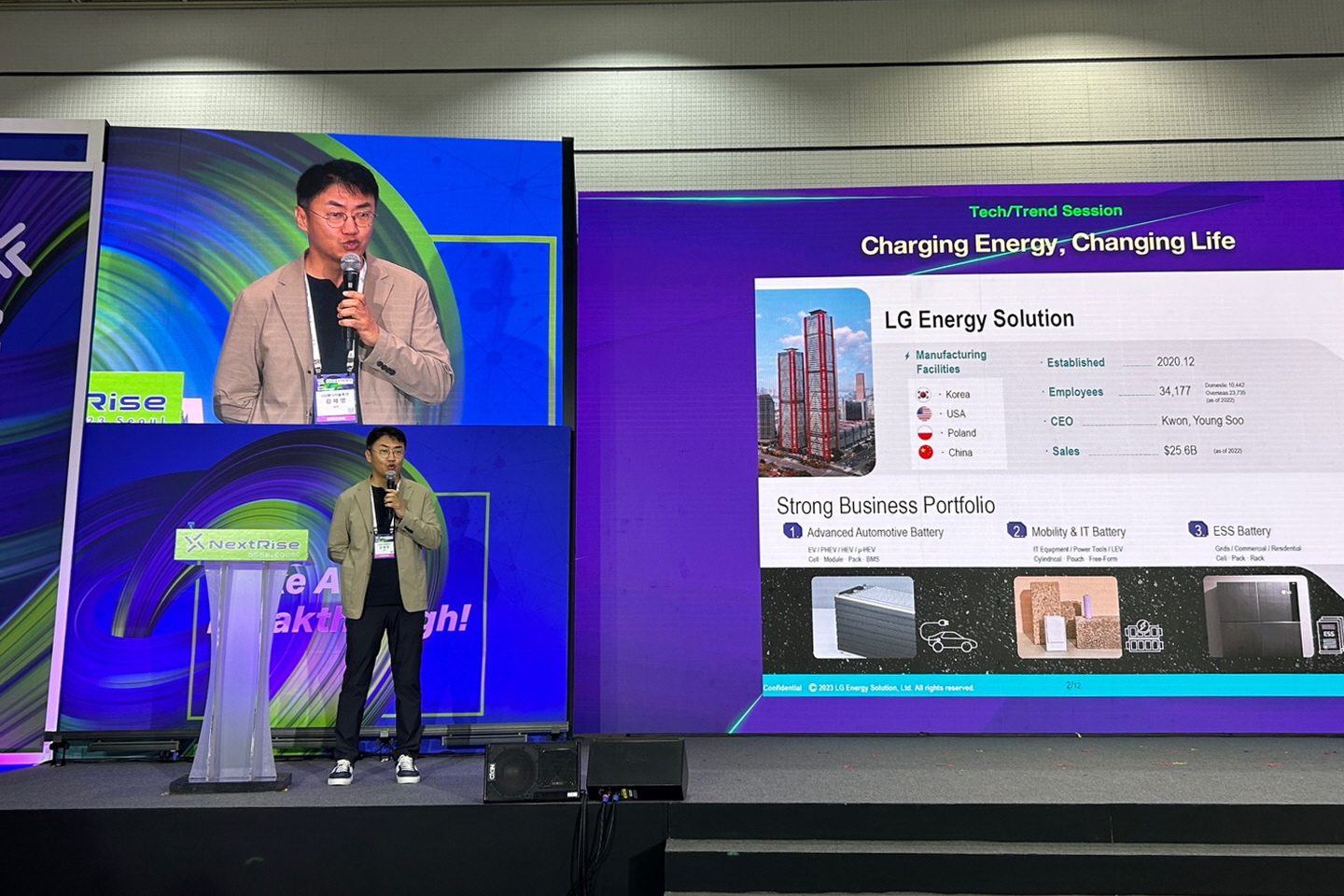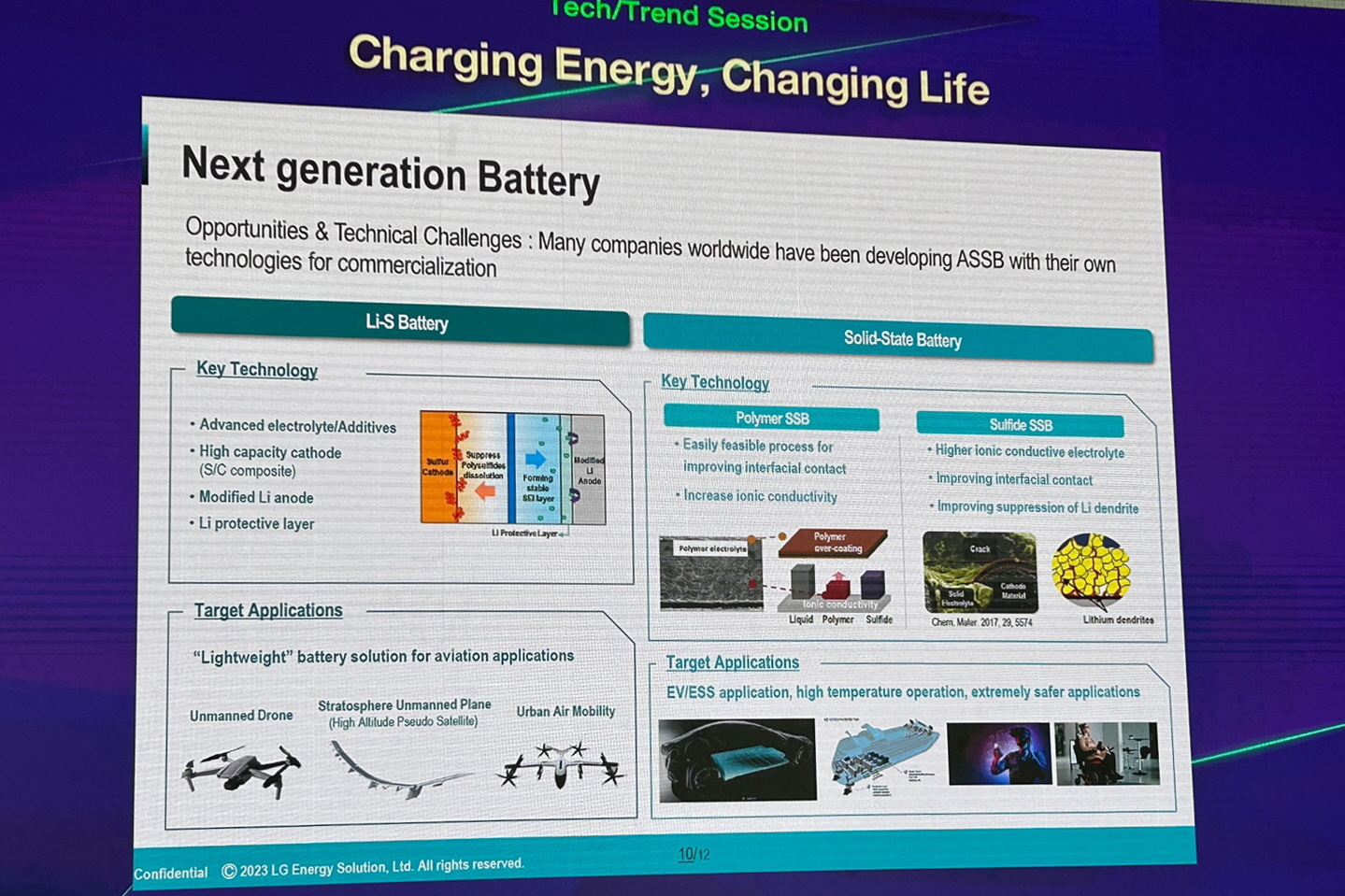100년 전 전기차가 미국 뉴욕의 도로의 주인공으로 떠오르며 대중화를 이루나 싶었으나 급격하게 쇠퇴한 바 이와 같은 실패를 반복하지 않기 위한 연구가 활발하게 진행되고 있다.

▲김제영 LG 에너지솔루션 상무
1910년 대 전기차 대중화 실패, 가격·충전 인프라·주행거리 원인
LG엔솔, "주행거리·충전속도 동시 충족 어려움 해결해 나갈 것"
100년 전 전기차가 미국 뉴욕의 도로의 주인공으로 떠오르며 대중화를 이루나 싶었으나 급격하게 쇠퇴한 바 이와 같은 실패를 반복하지 않기 위한 연구가 활발하게 진행되고 있다.
김제영 LG에너지솔루션 상무는 지난 2일 코엑스에서 열린 NextRise 2023 행사에서 ‘Charging Energy, Changing Life’를 주제로 발표하며 100년 전과 현재 같은 이유로 전기차 대중화에 어려움을 겪고 있다고 전했다.
김 상무는 1917년 미국 뉴욕에서 전기차의 점유율이 38%였던 역사를 소개하며 당시에도 전기차의 장점은 명확했다고 전했다.
100년 전 전기차가 대중화됐었던 시기 발명왕 에디슨은 전기차를 “No dangerous, evil-smelling gasoline and no noise”라 광고하며 가솔린 고유의 냄새가 나지 않고, 잔고장이 많은 단점을 상쇄시켰으며 소음이 적다는 특장점을 내세우며 도로를 점령해 나갔다.
고공행진을 달리던 전기차는 1920년 대 완전히 사라졌다.
가격, 충전 인프라, 주행거리가 산업 쇠퇴의 원인으로 꼽혔으며 현재 전기차 대중화가 어려움을 겪는 이유와 동일하다.

100년 전 당시 전기차는 3,000달러, 포드의 내연차는 260달러로 12배 가량 높은 가격에 가격 경쟁에서 밀렸으며 광대한 미국 영토에서 주행거리가 짧고, 충전이 어려운 전기차의 한계가 나타났다.
당시 Fritchle Electric은 자사 전기차의 주행거리를 100마일로 광고했으나 이는 불가능했을 것으로 예상했다.
김제영 상무는 과거에 비춰보았을 때 전기차의 수요를 끌어올리기 위해서는 앞선 세 가지의 문제 해결이 매우 중요하다고 말했다.
전기차의 가격을 저렴하게 하는 것도 중요하지만 충전 시간 감소에 대한 연구도 매우 중요하다고 김 상무는 전했다.
현재 급속 충전은 80%를 충전하는 데에 20분 정도가 소모된다.
현재 전기차 구매자들은 친환경에 기여한다는 자부심으로 이를 수용하는 분위기이나 대중화가 된다면 불편함을 야기할 수 있기에 충전 관련 연구와 발전이 절실하다.
그는 이어 주행거리와 충전속도를 동시에 충족시키기에는 이론적인 어려움이 있지만, 둘을 모두 최적화하도록 연구하는 것이 우리의 일이며 해 나갈 것이라고 덧붙였다.
그는 이어 배터리 소재에 대해 설명하며 양극제는 산화물 양극제, 음극제는 흑연 소재 위주로 카본 베이스의 흑연 소재 위주로 개발이 되고 있으며 실리콘 소재도 조금씩 쓰이고 있다고 설명했다.
리튬 메탈도 연구 중이나 위험성에 대한 연구가 더 이루어져야 할 것으로 판단된다.
분리막은 폴리에틸렌, 폴리프로필렌과 같은 소재를 사용하며 표면에 LG화학이 개발한 솔루션인 SRS(Safety Reinforced Seperator)으로 세라믹 코팅을 더한다.
최근 주목받고 있는 차세대 배터리는 Li-S(리튬 황) 배터리와 전고체 전지다.
Li-S 배터리는 음극은 리튬, 양극은 황을 쓰는 것으로 리튬과 황은 매우 가벼운 물질이기 때문에 무게 당 에너지 밀도가 매우 높다.

이는 현재 활발하게 개발되고 있는 UAM, 드론과 같은 비행체에 적합하다는 연구결과로 세계적인 주목을 받고 있다.
전고체 전지의 가장 큰 특징은 전해질이 고체라는 점이다.
전고체 전지는 전기차에 적용되기까지는 걸어야 할 길이 아직 남았다는 것이 김 상무의 이야기다.
김 상무는 많은 연구을 통해 고체 상태의 전해질 내부에서 리튬이 빠르게 이동시킬 수 있는 소재는 찾았으나 양극제와 고체 전해질, 이(異)종의 고체 간 리튬 이동 시에 발생하는 계면 간의 저항을 줄이는 데 많은 연구가 필요하다고 말했다.
한편 김제영 상무는 LG에너지솔루션의 오픈 이노베이션 사례도 소개했다.
LG에너지솔루션은 국내외 대학 및 기관들과 차세대 배터리 연구개발 과제를 위해 설립한 공동연구센터 ‘FRL(Frontier Research Lab)’에서 미국, 독일 등과 함께 연구를 지속해 나가고 있다.
또한 매년 배터리 챌린지 행사를 통해 배터리 분야의 기술력과 사업 모델을 보유한 스타트업을 발굴하고 있다.


